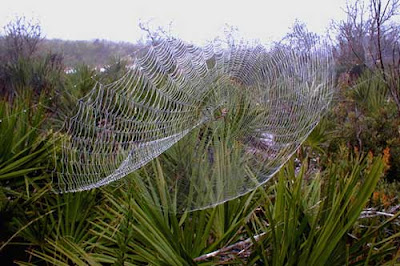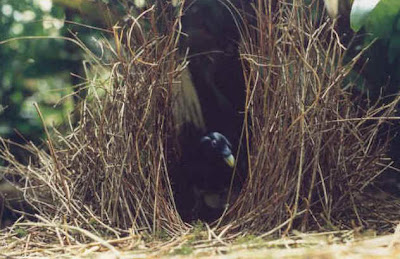 This is one of the better pictures of an orb web. Dr. James E. Carrel of U. Missouri has this image on his Biology of Spiders page there.
This is one of the better pictures of an orb web. Dr. James E. Carrel of U. Missouri has this image on his Biology of Spiders page there.So tell me, how much intelligence is indicated by these webs? In Built by Animals: The natural history of animal architecture by Mike Hansell, you'll read that, while humans are the only...the ONLY mammals that build trapping structures (nets, snares, deadfalls, etc.), thousands of species of invertebrates do so. Spiderwebs, of thousands of varieties, are the major realm of animal-built traps with which we are familiar, but by no means the only one.
In addition, while an orb web may be considered a home in addition to a trap, many spiders, such as tarantulas, make silk-lined homes in burrows or other cavities. Lots of nonhuman animals make homes: bird nests, chimp and orang nests, burrows by rabbits or moles or mice...and even fish!
 This illustration from the Project Gutenberg Ebook A Book of Natural History: Young Folks' Library Volume XIV, edited by David Starr Jordan, shows a female stickleback fish laying eggs in a nest built by her mate. The females of this genus of fish choose a mate based on the best nest.
This illustration from the Project Gutenberg Ebook A Book of Natural History: Young Folks' Library Volume XIV, edited by David Starr Jordan, shows a female stickleback fish laying eggs in a nest built by her mate. The females of this genus of fish choose a mate based on the best nest.I have seen, in shallow streams in springtime, what look like sunken auto tires covering large sections of the stream bed. These are also fish nests, but of a species I don't know. The males go to great trouble to clear and defend a circular area, and to heap a ring of debris around it, to attract females. Each ring is about 2/3 of a meter across or more, the size of a tire. How much smarts is needed by these fishes?
Dr. Hansell, author of several book on animal architecture, surveys the breadth of structures built by nonhuman animals, from termite mounds to mole rat burrows to the more familiar nests and webs. Many, many structures are found to result from repetitive actions that take advantage of material properties. Such structures fit the "good materials, small brains" hypothesis.
For example, the hexagonal cells in honeycombs aren't specifically shaped into hexagons, one by one. A group of bees will build waxen walls between one another, and when they are high enough, the bees will "shiver" together, raising the temperature until the walls soften and sort of relax into the hexagonal shape we see. Though a comb looks very uniform at first glance, a closer look reveals the kinds of small variation, including occasional 5- and 7-sided cells and small differences in diameter, that indicate their more "emergent" nature.
Stereotyped actions with specific materials indicate that such structures need little in the way of intelligent planning. While we need hundreds of planners to direct thousands of workers to build a skyscraper 350-300 times the height of a person (complete with plumbing, electricity, ventilation, and elevators), a nest of tropical termites that numbers in the millions, taking advantage of the properties of mud-plus-saliva and sometimes guided by air flow, can erect a structure 1,200-1,500 the height of a termite (if it could stand up to its full 5-6mm height).
In the last chapter of the book, the author goes 'way out on a (scientific) limb, discussing beauty. The subject is bowerbird bowers.
 This male Satin Bowerbird (see Australian Natural History Safari for more information and images) is busy guarding and decorating his bower. Soon a female will arrive to inspect it. She will visit several bowers, watching from within each as the male puts on a lively performance, before choosing one to mate with.
This male Satin Bowerbird (see Australian Natural History Safari for more information and images) is busy guarding and decorating his bower. Soon a female will arrive to inspect it. She will visit several bowers, watching from within each as the male puts on a lively performance, before choosing one to mate with.Dr. Hansell's thesis is that the experience is, for the female, pleasurable, and she seems to be guided by aesthetic pleasure in choosing a mate. Consider if she must use a "better bower & builder checklist": (1)size of bower, (2)pretty decorations, (3)vitality of male's display, (4)versatility of male's repertory, (5)who knows what?... She has to keep track of several factors each for several bowers and performances.
On the other hand, while the male's genetics and strength go into making the bower and the display, perhaps her genetics produce a synergistic emotional response: "Not bad", or "Very nice--worth a second look", or "Oh, BABY!" This is borne out by two observations: bower building and display performing both require practice on the male's part, and younger females are more attracted to flashier decorations and displays while older ones pay more attention to factors indicating strength and endurance on the male's part. (This sounds like human females, too)
Along the way, the author discusses the problem of aesthetic sense in animals. Just how likely is it that female bowerbirds take pleasure in a "good" bower? If pleasure takes less brain power than checklist tracking, it is actually quite likely, just as we use the pleasure of taste to choose good foods (and in the absence of modern manipulations of that sense, it's a pretty good one).
 Is this painting beautiful? Would you want it hanging on your wall? Would you pay for a copy? Somebody recently paid a few thousand dollars for it. It was painted by a chimpanzee under the care of Desmond Morris in the 1950s. Did the chimp think it beautiful?
Is this painting beautiful? Would you want it hanging on your wall? Would you pay for a copy? Somebody recently paid a few thousand dollars for it. It was painted by a chimpanzee under the care of Desmond Morris in the 1950s. Did the chimp think it beautiful?There are numerous opinions about the chimpanzee's feelings, and little to go by. There is more than one way to interpret his actions. When he stopped painting, was he satisfied it was complete, or did he just get bored? Sadly, this chimp wasn't taught sign language, and is now deceased, so we won't know...assuming signing chimps can truthfully describe their feelings!
A good book like this one raises as many questions as it answers. Good questions, that a lot of future work can spring from to gain more good answers, and even better questions.



No comments:
Post a Comment